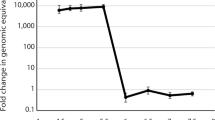Abstract
Since standard susceptibility tests reflect the physiological rather than the pathological conditions prevailing within an infected abdomen, as recently documented, the effect of reduced pH and pO2 and increased pCO2 on the activity of antibiotics in vitro was studied. MICs were determined in vitro under standard culture conditions (MICstandard) and modified conditions (MICmodification) simulating the previously determined pathological values. Various classes of antibiotics were affected differently by the modified conditions. However, within an antibiotic class similar results were obtained for gram-negative and gram-positive pathogens. Median MICmodification/MICstandard ratios were 4 for aminoglycosides, 2 for quinolones and clindamycin, 1 for cephalosporins, and 0.5 for penicillins and vancomycin. Anaerobic conditions and a pH of 6.4 further increased the ratio of aminoglycosides to 8. Ratios were similar within an antibiotic class at inocula of 105 or 107 cfu/ml. All MICs determined in tests with imipenem against gram-negative and gram-positive bacteria and with vancomycin against gram-positive organisms were below the susceptibility breakpoint, whatever conditions and inocula were employed. In contrast, the percentage of MICs in susceptibility range using high inocula and modified conditions decreased to 78 % for penicillins, 73 % for cephalosporins, 22 % for aminoglycosides, 11 % for quinolones and 0 % for clindamycin. In conclusion, routine susceptibility testing may overestimate the activity of aminoglycosides and underestimate the activity of beta-lactams under the conditions prevailing during abdominal infection.
Similar content being viewed by others
References
Simmen HP, Blaser J: Analysis of pH and pO2 in abscesses, peritoneal and drainage fluid in the presence and absence of bacterial infection during and following abdominal surgery. American Journal of Surgery 1993, 166: 24–27.
Finegold SM, Wexler HM: Therapeutic implications of bacteriologic findings in mixed aerobic-anaerobic infections. Antimicrobial Agents and Chemotherapy 1988, 32: 611–616.
Tally FP: Factors affecting the choice of antibiotics in mixed infections. Journal of Antimicrobial Chemotherapy 1988, 22, Supplement A: 87–100.
National Committee for Clinical Laboratory Standards: Methods for dilution antimicrobial susceptibility tests for bacteria that grow aerobically. Approved standard M7-A2. NCCLS, Villanova, PA, 1990.
National Committee for Clinical Laboratory Standards: Methods for antimicrobial susceptibility testing of anaerobic bacteria. Approved standard M11-A2. NCCLS, Villanova, PA, 1990.
Bryant RE: Effect of suppurative environment on antibiotic activity. In: Root RK, Sande MA (ed): New dimensions in antimicrobial therapy. Churchill Livingstone, New York, 1984, p. 313–337.
Bryant RE, Fox K, Oh G, Morthland VH: Beta-lactam enhancement of aminoglycoside activity under conditions of reduced pH and oxygen tension that may exist in infected tissues. Journal of Infectious Diseases 1992, 165: 676–682.
Hays RC, Mandell GL: pO2, pH and redox potential of experimental abscesses (38275). Proceedings of the Society of Experimental Biology and Medicine 1974, 147: 29–30.
Blaser J, Lüthy R: Comparative study on antagonistic effects of low pH and cation supplementation on invitro activity of quinolones and aminoglycosides againstPseudomonas aeruginosa. Journal of Antimicrobial Chemotherapy 1988, 22: 15–22.
Platt R, Rosner B: Effect of hydrogen ion and protein concentrations on the activity of beta-lactam antibiotics. Reviews of Infectious Diseases 1984, 6, Supplement 4: 829–834.
Ratcliffe NT, Smith JT: The mechanisms of reduced activity of 4-quinolone agents in urine. Fortschritte der antimikrobiellen und antineoplastischen Chemotherapie 1984, 3–5: 563–569.
Verklin RM, Mandell GL: Alteration of effectiveness of antibiotics by anaerobiosis. Journal of Laboratory and Clinical Medicine 1977, 89: 65–71.
Eng RHK, Cherubin C, Smith SM, Buccini F: Inoculum effect of beta-lactam antibiotics onEnterobacteriaceae. Antimicrobial Agents and Chemotherapy 1985, 28: 601–606.
Soriano F, Edwards R, Greenwood D: Effect of inoculum size on bacteriolytic activity of cefiminox and four other beta-lactam antibiotics againstEscherichia coli. Antimicrobial Agents and Chemotherapy 1992, 36: 223–226.
Andreasen J, Nissen B, Hartvig-Harzen S: Influence of carbon-dioxide tension and medium buffer concentration on medium pH and MIC values of erythromycin forEscherichia coli ATCC 25922 andStaphylococcus aureus ATCC 25923 in a micro-aerobic atmosphere. Acta Pathologica et Microbiologica Scandinavica (B) 1987, 95: 253–255.
Borobio MV, Perea EJ: Effect of inoculum, pH, and medium on the activity of ciprofloxacin against anaerobic bacteria. Antimicrobial Agents and Chemotherapy 1984, 25: 342–343.
Davey P, Barza M, Stuart M: Tolerance ofPseudomonas aeruginosa to killing by ciprofloxacin, gentamycin and imipenem in vitro and in vivo. Journal of Antimicrobial Chemotherapy 1988, 21: 395–404.
Shalit I, Welch D, San Joaquin VH, Marks ML: In vitro antibacterial activities of antibiotics againstPseudomonas aeruginosa in peritoneal dialysis fluid. Antimicrobial Agents and Chemotherapy 1985, 27: 908–911.
Brook I: Aerobic and anaerobic bacteriology of cholesteatoma. Laryngoscope 1981, 91: 250–253.
Brook I: Inoculum effect. Reviews of Infectious Diseases 1989, 11: 361–368.
Bryan LE, Kwan S: Mechanisms of aminoglycoside resistance of anaerobic bacteria and facultative bacteria grown anaerobically. Journal of Antimicrobial Chemotherapy 1981, 8, Supplement D: 1–8.
Potts DE, Levin DC, Sahn SA: Pleural fluid pH in parapneumonic effusions. Chest 1976, 70: 328–331.
Shohet A, Yellin J, Meyerovitch J, Rubinstein E: Pharmacokinetics and therapeutic efficacy of gentamicin in an experimental pleural empyema rabbit model. Antimicrobial Agents and Chemotherapy 1987, 31: 982–985.
Author information
Authors and Affiliations
Rights and permissions
About this article
Cite this article
König, C., Simmen, H.P. & Blaser, J. Effect of pathological changes of pH, pO2 and pCO2 on the activity of antimicrobial agents in vitro. Eur. J. Clin. Microbiol. Infect. Dis. 12, 519–526 (1993). https://doi.org/10.1007/BF01970957
Issue Date:
DOI: https://doi.org/10.1007/BF01970957




